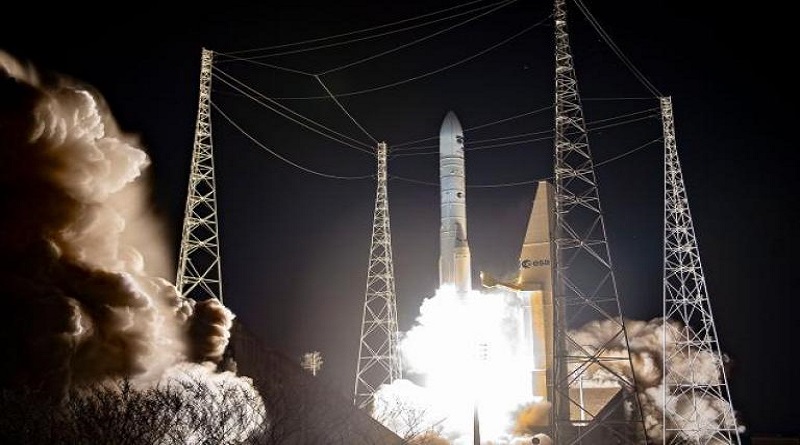New European satellite launch lifts weather forecasting to new heights
Photo caption: A rocket launches at night, producing bright flames and smoke, surrounded by tall support towers against a dark sky. Credit: Launch of Metop SGA-1 EUMETSAT
A new European weather satellite has successfully launched, in a boost for global monitoring of weather, climate and atmospheric composition and for the delivery of more precise forecasts and earlier warnings to help protect lives and property.
Metop Second Generation A1 (Metop-SGA1) lifted off on an Ariane-62 rocket from Europe’s Spaceport in Kourou, French Guiana, on 13 August. It is the first of the next generation of European polar-orbiting weather satellites and also hosts the new Copernicus Sentinel-5 atmospheric monitoring mission.
As the first satellite in the EUMETSAT Polar System – Second Generation (EPS-SG) programme. EPS-SG will also support economies across Europe, with an expected return on investment of at least 20 to 1, according to EUMETSAT.
It carries a suite of evolved and entirely new instruments designed to deliver essential data for weather forecasting, storm prediction, climate monitoring, and a wide range of other services and applications.
“Every time we check the weather, we rely on something bigger than technology. We rely on international trust, data, and cooperation. Reliable forecasts don’t happen by accident. They are made possible by a system of global solidarity. EUMETSAT is a key part of that global solidarity,” said WMO Secretary-General Celeste Saulo.
Now heading into a polar orbit around 800 kilometres above the Earth’s surface, Metop-SGA1 will soon begin transmitting a wealth of timely, high-resolution and high-quality observations from six complementary instruments. These data will continue the Metop series of satellites’ role as Europe’s most important source of meteorological observations for forecasts ranging from 12 hours to 10 days ahead.
Phil Evans, EUMETSAT Director-General, said: “Extreme weather has cost Europe hundreds of billions euros and tens of thousands of lives over the past 40 years – storms like Boris, Daniel and Hans, record heatwaves and fierce wildfires are just the latest reminders. The launch of Metop-SGA1 is a major step forward in giving national weather services in our member states sharper tools to save lives, protect property, and build resilience against the climate crisis.”
These positive impacts will be felt even beyond that and over the Atlantic, as Metop-SGA1 is Europe’s first contribution to the Joint Polar System with the United States’ National Oceanographic and Atmospheric Administration (NOAA).
Satellite data is the largest contributor of all types of observations to numerical weather prediction accuracy and more detailed observations from the satellite will enhance the complex calculations that can be made as part of weather forecasting, enhancing accuracy. This will make a major contribution to improving warnings in line with the international Early Warnings for All initiative.
As well as providing more detailed observations for numerical weather prediction models, the Metop-SG satellites will also provide important data for nowcasting (forecasts up to six hours ahead) particularly in northern latitudes where geostationary satellite data is sparser. In addition, the satellites will provide key data for monitoring atmospheric composition, the oceans, land surfaces and climate.
A satellite orbits above Earth, with a large swirling storm system visible over the planet’s surface below.
The Metop Second Generation satellites have been developed through partnerships between EUMETSAT, the European Space Agency, the European Union’s Copernicus programme, CNES, DLR, and an industrial consortium led by Airbus Defence and Space, involving more than 110 companies across 17 European countries. Metop-SG satellites are Europe’s contribution to the Joint Polar System, a shared initiative with the United States’ National Oceanic and Atmospheric Administration (NOAA)



